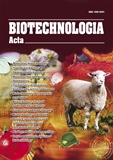ISSN 2410-7751 (Print)
ISSN 2410-776X (Online)

Biotechnologia Acta Т. 18, No. 2, 2025
P. 35-37 , Bibliography 9 , Engl.
UDC: 612.33+577.1
doi: https://doi.org/10.15407/biotech18.02.035
Full text:(PDF, in English)
METABOLIC CHARACTERISTICS OF GASTRIC CONTENTS UNDER CONDITIONS OF NEUROMUSCULAR DYSFUNCTION OF THE ESOPHAGOGASTRIC JUNCTION
A.M. HALINSKA 1,2, O.V. SEVERYNOVSKA 2, O.O. HALINSKYI 1
1SI "Institute of Gastroenterology of the National Academy of Medical Sciences of Ukraine", Kyiv
2Oles Honchar Dnipro National University, Dnipro, Ukraine
Neuromuscular dysregulation at the esophagogastric junction, characteristic of achalasia cardia, leads to alterations in the metabolic composition of gastric contents, particularly in acidity, pepsin concentration, bile acids, and protective mucosal factors. Investigating these changes is essential for understanding the pathophysiological mechanisms underlying motor-secretory dysfunction and the development of esophageal and gastric disorders. The relevance of such research is underscored by the limited available data on the biochemical composition of gastric juice in the context of esophageal dysfunction, especially achalasia cardia, thereby highlighting the need for further investigations in this area.
Aim. The work was purposed to determine the biochemical characteristics of gastric contents in neuromuscular dysfunction of the esophagogastric junction.
Materials and Methods. In total of 69 patients with achalasia of the cardia and 26 control subjects were examined. The following parameters were assessed: pH, pepsin, cholic acid, NOx, calcium, glycoproteins, fucose, glycosaminoglycans, and sialic acid.
Results. Patients demonstrated increased gastric content volume (2.9 times), cholic acid (1.8 times), and sialic acid (2.4 times), as well as elevated NOx (68.2%) and calcium (31.6%) levels. Glycoproteins (85.7%), fucose (73.0%), and glycosaminoglycans (35.5%) were significantly decreased.
Conclusions. Neuromuscular dysfunction is associated with alterations in the composition of gastric juice, weakening of protective factors, and accumulation of aggressive metabolites, indicating local homeostatic disruption.
Keywords: Achalasia of the cardia, gastric juice, mucosal protection, biochemical markers.
© Palladin Institute of Biochemistry of the National Academy of Sciences of Ukraine, 2025
References
1. Sharma, P., Yadlapati, R. (2021). Pathophysiology and treatment options for gastroesophageal
reflux disease: looking beyond acid. Ann. N. Y. Acad. Sci., 1486(1), 3–14. https://doi.org/10.1111/
nyas.14501
2. Vllahu, M., Voli, A., Licursi, V., Zagami, C., D’Amore, A., Traulsen, J., Woelffling, S., Schmid, M.,
Crickley, R., Lisle, R., Link, A., Tosco, A., Meyer, T. F., Boccellato, F. (2024). Inflammation
promotes stomach epithelial defense by stimulating the secretion of antimicrobial peptides in the
mucus. Gut. Microbes., 16(1), 2390680. https://doi.org/10.1080/19490976.2024.2390680
3. Ates, F., Vaezi, M. F. (2015). The pathogenesis and management of achalasia: current status and
future directions. Gut Liver., 9(4), 449–463. https://doi.org/10.5009/gnl14446
4. Ergun, P., Kipcak, S., Dettmar, P. W., Fisher, J., Woodcock, A. D., Bor, S. (2022). Pepsin and pH of
gastric juice in patients with gastrointestinal reflux disease and subgroups. J. Clin. Gastroenterol.,
56(6), 512–517. https://doi.org/10.1097/MCG.0000000000001560
5. Martinsen, T. C., Fossmark, R., Waldum, H. L. (2019). The Phylogeny and biological function of
gastric juice-microbiological consequences of removing gastric acid. Int. J. Mol. Sci., 20(23), 6031.
https://doi.org/10.3390/ijms20236031
6. Rudenko, A. I., Maykova, T. V., Mosiychuk, L. M., Ponomarenko, O. A., Tolstykova, T. M.,
Syrotenko, A. S. (2004). Clinical and laboratory assessment of the functional state of the secretory
glands of the stomach. Kyiv. 1–23.
7. Mittal, R., Vaezi, M. F. (2020). Esophageal motility disorders and gastroesophageal reflux disease.
N. Engl. J. Med., 383(20), 1961–1972. https://doi.org/10.1056/NEJMra2000328
8. da Rocha, J. R., Ribeiro, U., Cecconello, I., Sallum, R. A., Takeda, F., Nasi, A., Szachnowicz, S.
(2009). Gastric secretory and hormonal patterns in end-stage chagasic achalasia. Dis. Esophagus.,
22(7), 606–610. https://doi.org/10.1111/j.1442-2050.2009.00961.x

